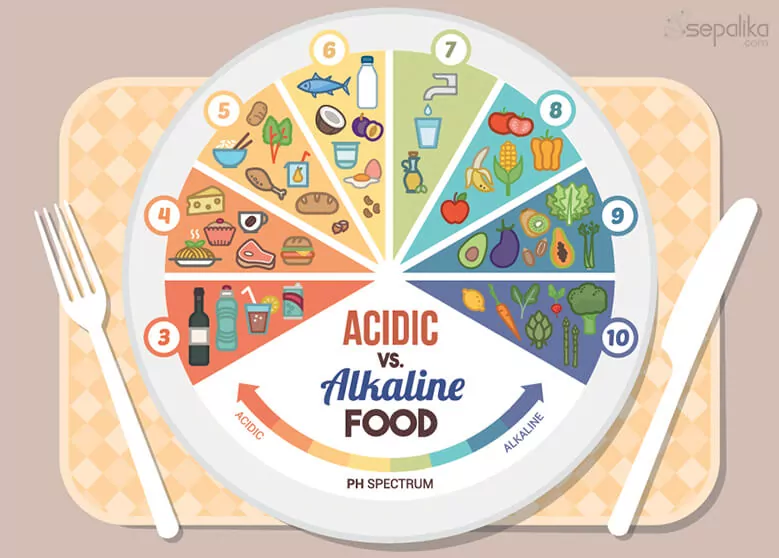PCOS test is based on the Rotterdam criteria for diagnosing PCOS.

Living Well
In today’s fast-paced world, we often forsake our health for convenience and speed. But in the long run these quick, short-term fixes may actually slow us down by contributing to disease, insulin resistance, bone loss, weight gain, low energy and pain.
One of the contributors to this may be low grade acidosis in the body. This is often expressed by people as a “pH level” being too acidic.
Acidity and alkalinity are expressed on the pH (potential of hydrogen) scale, which ranges from 0 (strongly acidic) to 14 (strongly basic or alkaline). A pH of 7.0, in the middle of this scale, is neutral.
Blood is normally slightly alkaline, with a normal pH range of 7.35 to 7.45. The body usually keeps the pH of blood in a very tight band, close to 7.40
The idea of being ‘too acidic’ and how this could make you susceptible to disease has been around for a long time and is often discounted by medical doctors. They say that since the pH level of the blood (acidity or alkalinity measured through a blood test) shows no change, irrespective of the diet you eat, the idea of being ‘acidic’ must be false.
Doctors of naturopathy and alternative medicine swear by treating “acidosis” with the right diet, lifestyle and supplements. They say that while the body has extremely efficient buffering systems to maintain a stable blood pH, diet and lifestyle choices can affect the pH inside the cells, in the intracellular space. Low-grade acidosis in these areas can cause disruption of enzyme function, loss of insulin sensitivity, and cause cellular metabolic changes that lead to illness.

acidic v/s alkaline food
Yes, they are, to the extent that you can measure how acidic or alkaline a food is by say, taking a portion of it and analyzing it. Lemon juice is highly acidic, with a ph balance diet of 2.2, while Brussel sprouts can have a pH of around 6.4. However, when speaking about diet-induced low-grade acidosis, the discussion is no longer about the pH of the food or beverages consumed. It is about how these foods affect the acid/base levels in the intracellular spaces of the body.
Diet and lifestyle factors play a major part in whether we function optimally and in balance or below par, with an overly acidic system.
In a contribution to the International Acid-Base Symposium, researcher Jürgen Bormann noted that, “although homeostatic mechanisms and the kidneys’ capacity to excrete acids can prevent strong diet-induced alterations in blood ph balance diet, even moderate increases in blood hydrogen ion levels (increased acidity) as a result of unfavorable diet composition can have long-term consequences for the occurrence and progression of a number of diseases”.
Studies show that the standard western diet tends to generate high levels of metabolic acids and inflammation; in part due to high salt intake, high processed foods and sugars and a reduced intake of dietary elements such as potassium, found in plant foods.
As mentioned earlier, except under extreme circumstances, even with our highly refined diet, blood pH is maintained within a “normal” range due to the body’s efficient balancing systems. However, though blood ph balance diet is maintained at a “safe” level, the body equilibrates closer to the more acidic level of the range instead of calibrating toward the more alkaline end of the normal range: this constant low-grade acidosis can have severe metabolic and health consequences if it remains for a long term.
Research suggests that diets which constantly generate a higher acid load, in conjunction with a natural age-related decline in kidney function, are the two main factors that render the body less capable of excreting metabolic acids, leading to a greater risk for the development of chronic metabolic disorders over time.
Absolutely. The ideal pH varies throughout your body for many reasons. While we require body fluids such as blood and the fluids inside and between our cells to be more alkaline, areas such as the bowel and skin will be slightly more acidic which, amongst other things, helps keep unfriendly bacteria away. Then of course there is the hydrochloric acid in our stomach that needs to be highly acidic, with a ph balance diet of around 2.5, so that it is able to easily break down components in our foods.
Again, it’s a delicate balance; but overall the body requires a slightly alkaline environment, especially in it’s body fluids, in order to function optimally.
While optimal ph balance diet is well monitored and vital to maintain, we don’t always make it easy for our body to hold onto this balance.
The Standard American Diet (SAD) and lifestyle may be putting you at risk for chronic disease and an overly acidic system, due to it being:
Decreased bone and muscle mass in adults is a well-documented consequence of severe metabolic acidosis. In the case of ongoing low-grade acidosis, the skeletal system continues its natural buffering process in order to maintain acid-balance homeostasis, a process that over time may become detrimental to bone mineral content and bone mass.
It has been demonstrated that even the slightest degree of metabolic acidosis produces insulin resistance in healthy humans and many recent epidemiological studies link metabolic acidosis indicators with both insulin resistance and systemic hypertension.
The strongly acidogenic diet consumed in developed countries produces a lifetime (slightly) acidotic state, exacerbated by excess body weight and aging, which may result in metabolic syndrome, and type 2 diabetes, contributing to cardiovascular risk.
Recent research has now shown that dietary acid load is the best predictor of kidney stones.
In 2008, a study examining the associations disorders in women, found that acidic dietary loads were positively associated with higher systolic and diastolic blood pressure, as well as increased LDL-cholesterol, basal metabolic index (BMI) and waist circumference.
Symptoms often associated with low-grade acidosis include:
Acid/alkaline tests can be bought cheaply from most drugstores, however using first morning urine is an inaccurate test to assess body and blood acid load.
THE FINAL VERDICT: Low grade acidosis is a real problem. Fortunately, with just a little bit of will and discipline, tackling it is fairly easy. Eating alkalizing foods and supplementing with the right vitamin and minerals can help you get to a ph balance diet and heal your body.